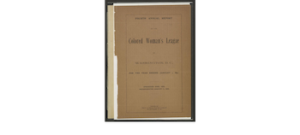
CWL, 1897 annual report
*The Colored Women's League (CWL) of Washington, D.C., was incorporated on this date in 1894. This women's club's primary mission was the national union of women of color.
Several prominent Black women in Washington, D.C., met to discuss creating a club devoted to improving the conditions of black children, women, and the urban poor. Some of these women were Anna J. Cooper, Cook, Mary Church Terrell, Ida B. Wells, Charlotte Forten Grimké, Mary Jane Patterson, Evelyn Shaw, and Jane Eleanor Datcher. Helen Appo Cook was elected the first president.
The Colored Women's League was a coalition of 113 organizations, and the goal of national unity was at the forefront of the club's objectives. In a letter written in 1894 to The Woman's Era, the first national newspaper published by and for African American women, Cook reported a few league accomplishments. These included hosting a series of public lectures for girls at local high schools and Howard University, raising $1,935 towards a home for the league, creating classes for German, English Literature, and hygiene, and establishing a sewing school and mending bureau with 88 students and ten teachers. According to historian Fannie Barrier Williams, this organization had the largest membership of any African American women's club in the country. Mary Church Terrell also provided updates about the CWL's efforts to this newspaper.
Although the primary goal of the CWL was national unity for women of color, they initially declined to join the National Federation of Afro-American Women because President Cook did not have the authority to commit to the league. However, Josephine St. Pierre Ruffin's appeal to protect the reputation of black women influenced the political agenda of the CWL. Ruffin's appeal was composed in response to an editorial published by a Southern white journalist, in which the author ridiculed the moral character of black women. To combat the widespread influence of negative stereotypes of black women, Margaret Murray Washington, the president of the National Federation of Afro-American Women, and Helen A. Cook began making plans to discuss consolidating their two organizations.
The Colored Women's League and the Federation of Afro-American Women had similar objectives: advancing the conditions for black women, children, and the underprivileged. Before merging, these organizations only sometimes saw eye-to-eye. The most significant factor contributing to this rivalry was the debate about the first to be officially recognized as a national organization. Mary Church Terrell, the first president of the NACW, explains that "although the CWL was the first to suggest there should be a national organization," the first organization of Black women to assemble nationally was the National Federation of Afro-American Women. After the NACW's creation, the national organization's contest for leadership created another short rivalry. Seven delegates in the election process represented each organization, so ties of 7-7 made the voting process difficult. Eventually, at thirty-three and pregnant, Mary Church Terrell of the Colored Women's League was named the first president of the NACW.
Many members of the league, especially those in leadership positions, had high social standings. Some even called members of the league "female aristocrats of color." Therefore, the league faced several critiques. Some argued that the ideology of racial uplift was classist. Nevertheless, the success of the CWL inspired other black women to become aware of the possibility of creating a united front for themselves and creating their own clubs. On July 21, 1896, the Colored Women's League and the Federation of Afro-American Women merged to form the National Association of Colored Women (NACW), with Mary Church Terrell as the first president. It extended the Colored Women's League's objectives to a national agenda for uplifting black women, as follows:
· To unite colored women nationally.
· To improve the conditions of black women locally and nationally.
· To collect all facts obtainable to show the "moral, intellectual, industrial and social growth and attainments of our people, to foster unity of purpose, to consider and determine methods which will promote the interests of colored people [in every direction]."
· To create a kindergarten for the black community.
· To educate the youth.
· To teach evening classes in literature, language, and other subjects.